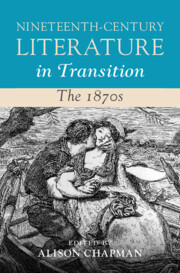Refine search
Actions for selected content:
63 results
4 - Periodicals, 1866–1914
-
- Book:
- Slavery in the International Women's Movement, 1832–1914
- Published online:
- 19 May 2025
- Print publication:
- 05 June 2025, pp 124-178
-
- Chapter
-
- You have access
- Open access
- HTML
- Export citation
Chapter 5 - Victorian Pepys
-
- Book:
- The Strange History of Samuel Pepys's Diary
- Published online:
- 24 April 2025
- Print publication:
- 24 April 2025, pp 84-107
-
- Chapter
- Export citation
Chapter 9 - ‘Verses, Good and Bad’
-
-
- Book:
- Nineteenth-Century Literature in Transition: The 1870s
- Published online:
- 30 January 2025
- Print publication:
- 06 February 2025, pp 186-205
-
- Chapter
- Export citation
Chapter 1 - Forging Literary Connections
- from Part I - Protest
-
- Book:
- Vivisection and Late-Victorian Literary Culture
- Published online:
- 30 January 2025
- Print publication:
- 06 February 2025, pp 23-48
-
- Chapter
- Export citation

Nineteenth-Century Literature in Transition: The 1870s
-
- Published online:
- 30 January 2025
- Print publication:
- 06 February 2025
Chapter 1 - Mobility and Spectatorship in the Early Eighteenth-Century City
-
- Book:
- The Art of Walking in London
- Published online:
- 19 December 2024
- Print publication:
- 23 January 2025, pp 26-63
-
- Chapter
- Export citation
Chapter 3 - ‘Aussi hardi … qu’aucun philosophe en France’:
- from Part I - Reception
-
-
- Book:
- Hume's <i>Essays</i>
- Published online:
- 02 January 2025
- Print publication:
- 09 January 2025, pp 52-70
-
- Chapter
- Export citation
2.9 - The Self-Publisher
- from History 2 - Mechanisms
-
-
- Book:
- The New Cambridge History of Russian Literature
- Published online:
- 31 December 2024
- Print publication:
- 12 December 2024, pp 369-387
-
- Chapter
- Export citation
Chapter 14 - Haitian Writers and the Forging of a National Voice through Periodicals in the Twentieth Century
-
-
- Book:
- A History of Haitian Literature
- Published online:
- 07 November 2024
- Print publication:
- 21 November 2024, pp 251-266
-
- Chapter
- Export citation
Chapter 16 - Occupation-Era Literature in Haiti
-
-
- Book:
- A History of Haitian Literature
- Published online:
- 07 November 2024
- Print publication:
- 21 November 2024, pp 290-302
-
- Chapter
- Export citation
4 - The History of Learning and Research Infrastructures
- from Part II - Approaches to Knowledge
-
- Book:
- Curating the Enlightenment
- Published online:
- 07 December 2024
- Print publication:
- 07 November 2024, pp 88-132
-
- Chapter
- Export citation
23 - Victorian Essays in Criticism
- from Part III - Assaying Culture, Education, Reform
-
-
- Book:
- The Cambridge History of the British Essay
- Published online:
- 31 October 2024
- Print publication:
- 04 July 2024, pp 340-355
-
- Chapter
- Export citation
25 - Essays in the ‘Golden Age’ of the British Newspaper
- from Part III - Assaying Culture, Education, Reform
-
-
- Book:
- The Cambridge History of the British Essay
- Published online:
- 31 October 2024
- Print publication:
- 04 July 2024, pp 373-388
-
- Chapter
- Export citation
43 - The Essay and the Public Intellectual
- from Part V - The Essay and the Essayistic Today
-
-
- Book:
- The Cambridge History of the British Essay
- Published online:
- 31 October 2024
- Print publication:
- 04 July 2024, pp 650-664
-
- Chapter
- Export citation
11 - Clubs and Coffeehouses: Sociability and the Essay
- from Part II - The Great Age of the British Essay
-
-
- Book:
- The Cambridge History of the British Essay
- Published online:
- 31 October 2024
- Print publication:
- 04 July 2024, pp 152-166
-
- Chapter
- Export citation
22 - The Essay and the Rise of University English
- from Part III - Assaying Culture, Education, Reform
-
-
- Book:
- The Cambridge History of the British Essay
- Published online:
- 31 October 2024
- Print publication:
- 04 July 2024, pp 325-339
-
- Chapter
- Export citation
44 - Essayism in Literary Theory
- from Part V - The Essay and the Essayistic Today
-
-
- Book:
- The Cambridge History of the British Essay
- Published online:
- 31 October 2024
- Print publication:
- 04 July 2024, pp 665-680
-
- Chapter
- Export citation
26 - The Essay in the Age of Chartism
- from Part III - Assaying Culture, Education, Reform
-
-
- Book:
- The Cambridge History of the British Essay
- Published online:
- 31 October 2024
- Print publication:
- 04 July 2024, pp 389-404
-
- Chapter
- Export citation
3 - Cultivating Australian Poetry through Periodicals
- from Part I - Change and Renewal
-
-
- Book:
- The Cambridge Companion to Australian Poetry
- Published online:
- 06 June 2024
- Print publication:
- 13 June 2024, pp 54-70
-
- Chapter
- Export citation
Myth 2 - That Most European Naturalists Before Darwin Did Not Think That Species Change Was Possible
-
-
- Book:
- Darwin Mythology
- Published online:
- 30 May 2024
- Print publication:
- 06 June 2024, pp 24-35
-
- Chapter
- Export citation
